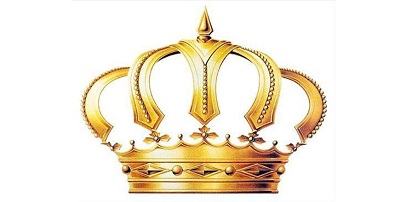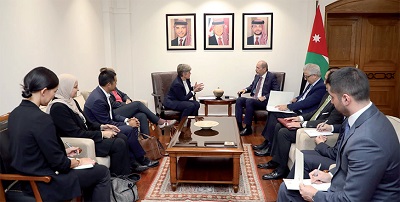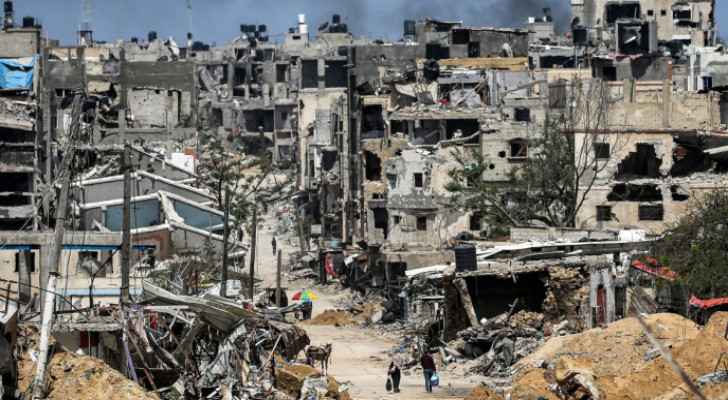Soleimani is Gone, Will his Plan Survive - By Eyad Abu Shakra, Asharq Al-Awsat
Qassem Soleimani exiting the Middle East’s arenas is undoubtedly a significant landmark; for the man was able to become a symbol, even a legend, in addition to being the epitome of a project and the face of a conspiracy.
Many of those who were monitoring Soleimani’s ascendancy regarded him as the symbol of the Iranian expansionist imperial dream, which threatens both the existence and identity of the Arab peoples.
Indeed, for decades, he never failed to enhance his symbolism in the Arab world where many worried about his role, while others became henchmen to him and to the authority he represented. As for Iran itself, he was turned into a legend as the importance of the Revolutionary Guards (the IRGC) grew, including the Quds Force led by Soleimani from 1998 until his death a few days ago in Baghdad.
The Quds Force has actually been a fundamental element in the IRGC’s religious – liberation ‘legitimacy’. It has also become a ‘state within a state’ and a money and investment ‘mafia’, beside its role as a ‘special force’ entrusted with brutal suppression in defense of the Wilayat al-Faqih regime.
Here it is worth mentioning that the issue of Al Quds – i.e. Jerusalem – has never been absent from the IRGC’s rhetoric because it is part of the regime’s ‘legitimacy’ as far as external operations are concerned. In other words, the regime’s justifications of occupying other countries and exporting the ‘Khomeinist experiment’. Having said this, one must remember that all the Quds Force’s military activities were never close to Jerusalem; but rather, more interested in shelling Homs, destroying Aleppo, depopulating Zabadani, invading Beirut, and handing over Mosul to ISIS!
Yes, Soleimani became a legend to the younger Iranians, in parallel with the expanding economic and military power of the IRGC, and its increasing control of the political establishment, and its ‘conquests’ in neighboring Arab countries. Incidentally, the IRGC - specifically, the Quds Force – has been the incubator of almost all the sectarian Shiite militias currently active in Iraq, Syria, Lebanon and Yemen.
Moreover, in Gaza, subservience to the IRGC has transcended sectarian divides, as ‘Islamic Jihad’ has become an Iranian arm, and so has a large section of ‘Hamas’. Also in Lebanon (the Resistance Brigades) and Syria (National Defence Forces) militias, which are not exclusively Shiite, were also founded to serve Iran’s project for which Tehran invented the name “Resistance” and sold to the masses.
This “Resistance” which is supposed to mean “Resisting Israel”, has not attacked Israel from south Lebanon since 2006. In Gaza, field hostilities have been nothing but messages exchanged between Tel Aviv and Tehran, and drawing the rules of engagement, without ever reaching the level of “resisting’ occupation let alone a strategy of “liberation”!
Even worse, looking at the way the “Resistance” dealt with the Syrian Revolt it becomes clear that it is based on a plan for Iranian regional hegemony leading, eventually, to a major deal with Israel and Turkey.
It also has to be said that the decision to suppress the uprising of the Syrian people was not taken by Hezbollah in Lebanon, or “Asa’ib Ahl Al-Haq” and “Liwa Abu Al-Fadhl A-Abbas” militias in Iraq; and sure enough not the Afghan Hazara “Liwa Fatemiyoun”, but in Tehran. In the ‘kitchen’ of the Iranian leadership and its IRGC. The systematic suppression and broad collective actions of sectarian militias was by far larger than merely “defending Lebanese-inhabited border villages inside Syria” or protecting Shiite shrines and ‘holy sites’ here and there. They were and are part of a regional map that was drawn with the Khomeinist Revolution and its plans to ‘export’ it.
Even the phenomenon of ISIS which proved to be instrumental in aborting the Syrian Revolt, and the pro-Iran militias’ control over Soleimani’s Arab ‘protectorates’, were in essence different from what the international community – as well as some Arabs – wanted to see.
Violent extremism that imbues some kind of sectarian fundamentalism is not something new; indeed, Arabs and Muslims have known it since Islam’s early days. Furthermore, throughout Islamic history many violent ultra-extremist groups of all creeds and sizes appeared and disappeared.
As for the idea of the ‘Caliphate’ – with ISIS as its latest claimants –, it did not recently emerge from Al-Qaeda or any of the extremist organizations during the last couple of centuries. However, Iran’s relatively recent exploitation of ultra-extremist Islam, in order to serve its own political agenda, has been quite significant.
Tehran has happily co-existed with extremist groups in Afghanistan. This ‘co-existence’, followed by ‘mutual neutralization’, reached high levels of understanding between Tehran and Osama bin Laden; and later between Tehran and Al Qaeda as well as Taliban.
In Syria, it was interesting how the pro-Iran Assad regime ‘co-existed’ with ISIS and its conquests. The Assad regime rarely attempted to bomb ISIS’ stronghold – all vulnerable to air attacks – while ruthlessly bombing civilian neighborhoods in Homs Aleppo, Barada Valley. On the other hand, ISIS spent more time attacking Syrian opposition areas than attacking the positions of the regime, with whom it also concluded oil deals!
The situation was not much different in Iraq. Under the Pro-Iran former Prime Minister Nuri Al-Maliki thousands of Iraqi army troops hurriedly withdrew from the city on Mosul in face of a few hundred ISIS fighters leaving behind brand new army weapons, full bank vaults, and a semi-deserted and broken city, very much in line of Tehran’s policy of uprooting and displacement.
Qassem Soleimani was one of the most important ‘executers’ of this policy of uprooting and displacement, which has nurtured, and later ‘demonized’ Sunni extremism in order to make Shiite extremism look moderate in comparison. Here, we must recall Barack Obama’s description of the Mullahs’ as being “not suicidal”; a belief he interpreted by deserting the Syrian people, ruining Washington’s traditional Arab relations, and betting on Tehran as a future friend and ally.
Today, with Soleimani out of the picture thanks to Donald Trump’s surgical strike, the Middle East must resort to deep thinking rather than jubilation.
What is hoped from Washington, now, is a new and clear strategy towards Tehran’s dangerous regional project, and a serious policy of confrontation rather than mere ‘punishment’ in the forlorn hope that Tehran would change its behavior!
Latest News
 King orders holding parliamentary elections in accordance with law, checks on electoral commission’s preparations
King orders holding parliamentary elections in accordance with law, checks on electoral commission’s preparations- N. Macedonia starts elections that could decide stalled EU talks
 US Senate passes bill for aid to Israeli Occupation, Ukraine, Taiwan
US Senate passes bill for aid to Israeli Occupation, Ukraine, Taiwan Safadi discusses support to Syrian refugee with DRC
Safadi discusses support to Syrian refugee with DRC Israeli Occupation aggression on Gaza enters 200th day
Israeli Occupation aggression on Gaza enters 200th day
Most Read Articles
- US president signs bill to provide new aid for Ukraine
- Prime minister directs government to support IEC ahead of upcoming elections
- Palestinian prime minister, Jordanian ambassador discuss humanitarian efforts in Palestine
- US Supreme Court seems split on Idaho abortion ban
- UAE announces $544m for repairs after record rains
- Iran cuts Syria presence after strikes blamed on Israel —monitor
- Four dead as floods wreak havoc in Kenyan capital
- Vaccines saved at least 154 million lives in 50 years — WHO
- Germany nudges up growth forecast, ailing economy at 'turning point'
- Israel pummels Gaza after US Congress approves military aid